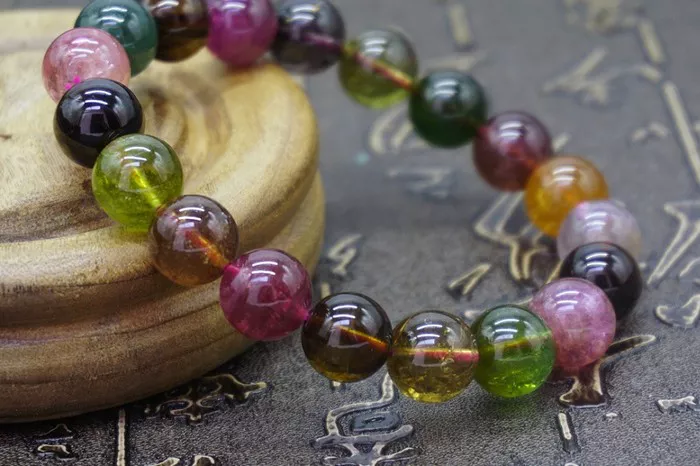Jewelry has always been a symbol of elegance, status, and personal taste. Among the myriad of gemstones, pink tourmaline stands out with its unique charm and delicate color. However, for those who are unfamiliar with gemology, understanding the hardness of pink tourmaline may be a bit challenging. This article aims to provide a detailed introduction to pink tourmaline, focusing on its hardness, and explaining the related concepts in a popular science style.
What is Pink Tourmaline?
Tourmaline is a type of borate silicate mineral, belonging to the tourmaline group of minerals. It is known for its wide range of colors, which can be found in almost any shade of the rainbow. Pink tourmaline, as a member of this group, boasts a soft and romantic pink hue, making it a popular choice for jewelry. Its color ranges from pale pink to a deeper, more intense pink, each shade offering a unique charm.
Understanding Hardness: The Mohs Scale
Before diving into the hardness of pink tourmaline, it’s essential to understand the concept of hardness in gemology. Hardness is a measure of a mineral’s resistance to scratching or abrasion. The most commonly used scale to measure hardness is the Mohs scale, which ranges from 1 to 10.
Mohs Scale Basics
The scale is named after Friedrich Mohs, a German mineralogist who developed it in 1812. Each number on the scale represents a specific mineral that is used as a reference point. For example, a mineral with a hardness of 1 can be scratched by anything harder than it, while a mineral with a hardness of 10 cannot be scratched by anything else on the scale.
Examples of Minerals on the Mohs Scale
-
- Talc (1): The softest mineral on the scale, it can be scratched by a fingernail.
- Gypsum (2): Known for its softness, gypsum can be easily scratched by a coin.
- Calcite (3): Common in limestone, calcite can be scratched by a copper penny.
- Fluorite (4): Often found in cave formations, fluorite can be scratched by a steel knife blade.
- Apatite (5): A common phosphate mineral, apatite can be scratched by a glass blade.
- Orthoclase (6): A type of feldspar, orthoclase can be scratched by a steel file.
- Quartz (7): The most common mineral in the Earth’s crust, quartz is scratch-resistant and can only be scratched by harder minerals like topaz.
- Topaz (8): A popular gemstone, topaz can scratch quartz but is scratched by corundum.
- Corundum (9): Sapphire and ruby are both varieties of corundum, which is one of the hardest minerals on Earth. Only diamonds can scratch it.
- Diamond (10): The hardest mineral on Earth, diamonds can scratch any other mineral on the Mohs scale.
Hardness of Pink Tourmaline
Pink tourmaline falls within a specific range on the Mohs scale. Generally, tourmaline has a hardness rating of 7 to 7.5. This means that pink tourmaline is relatively scratch-resistant and can withstand the wear and tear of daily use, making it a suitable choice for jewelry.
Comparison with Other Gemstones
Emerald (7.5-8): While emeralds are slightly harder than pink tourmaline, they are also more brittle and prone to fractures.
Sapphire and Ruby (9): Corundum gemstones like sapphires and rubies are harder than pink tourmaline, making them more durable.
Morganite (7.5-8): Morganite, another variety of beryl, shares a similar hardness range with pink tourmaline.
Wear and Tear Resistance
The hardness of pink tourmaline ensures that it can withstand the normal wear and tear associated with daily jewelry use. However, it’s still advisable to handle it with care, especially when exposing it to abrasive surfaces or harsh chemicals.
Factors Influencing Hardness
The hardness of pink tourmaline can vary depending on several factors, including its composition, crystal structure, and origin.
-
Composition: The boron and silicate content of tourmaline can affect its hardness. Variations in these components can lead to slight differences in hardness among different samples of pink tourmaline.
-
Crystal Structure: The internal arrangement of atoms within the crystal structure of pink tourmaline can also influence its hardness. Minerals with a tightly packed crystal structure tend to be harder than those with a looser structure.
-
Origin: Tourmaline is found in various locations worldwide, and the specific geological conditions where it forms can affect its hardness. For example, tourmaline from Brazil may have slightly different hardness properties compared to tourmaline from Madagascar.
Practical Implications of Hardness
The hardness of pink tourmaline has several practical implications for jewelry design, care, and maintenance.
-
Jewelry Design: The durability of pink tourmaline allows jewelers to create intricate designs without worrying about the gemstone breaking or scratching easily. This versatility makes pink tourmaline suitable for a wide range of jewelry styles, from simple pendants to elaborate engagement rings.
-
Care and Maintenance: While pink tourmaline is relatively durable, it still requires proper care and maintenance to keep it looking its best. Regular cleaning with a soft cloth and warm water can help remove dirt and grime. Avoid using harsh chemicals or abrasive cleaners, as they can damage the gemstone’s surface.
-
Setting and Mounting: When setting pink tourmaline in jewelry, it’s important to choose a mounting that protects the gemstone from impact and abrasion. Prong settings, which hold the gemstone securely in place with small metal claws, are a popular choice for pink tourmaline.
conclusion
Pink tourmaline is a beautiful and versatile gemstone that boasts a hardness rating of 7 to 7.5 on the Mohs scale. This makes it suitable for jewelry that can withstand the rigors of daily wear and tear. Understanding the factors that influence hardness, such as composition, crystal structure, and origin, helps us appreciate the unique properties of pink tourmaline. With proper care and maintenance, pink tourmaline jewelry can remain a cherished possession for generations to come.
Related topic:
- Is Green Tourmaline Valuable?
- How to Identify Green Tourmaline
- How to Choose the Right Amazon Tourmaline Necklace for Yourself?


